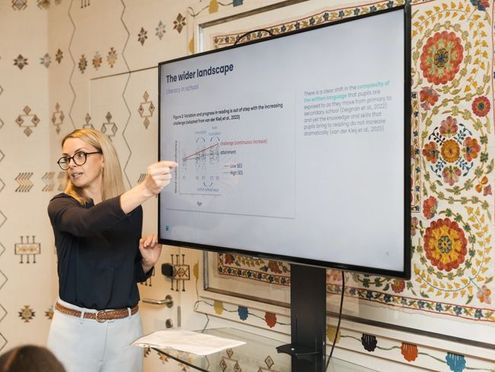What are the two types of motivation?
Before diving in, here’s a brief outline of what we mean by intrinsic and extrinsic motivation:
- Autonomous intrinsic motivation: Intrinsic motivation depends on the learner – the value they perceive the task to have, their own self-motivation, their enjoyment of the task, and a variety of other factors.
- Controlled extrinsic motivation: This goes beyond a learner’s personal view of the task. Extrinsic motivation is influenced by the consequence or reward for completing an action.
Why learner motivation on Bedrock is crucial
The Education Endowment Foundation recommends schools teach Tier 2 and Tier 3 vocabulary explicitly, driven by data.
Geoff Barton follows on from this, stating in the 2018 Oxford Language Report that “whole-school literacy remains the final frontier in our schools” (OUP, 2018: 9). The language gap between learners has an impact on their ability to access their education, which impacts them in various ways throughout their life.
It is clear from leading research that the more we teach literacy explicitly, through Tier 2 vocabulary, Tier 3 vocabulary and grammar, the more we motivate our learners to achieve – but keeping learners motivated isn’t always that simple.
Motivating learners: the difference parent engagement can make
The 2020 Oxford Language Report concludes that “[f]ostering an effective partnership between school and home is critical.”
90% of teachers surveyed believe that parents and carers are “very important” in the development of their child’s vocabulary.
Within the Department for Education’s review of best practice in parental engagement, collaboration is recommended not only between parents and teachers, but also between areas, schools and communities. This “outward facing strategy” is in line with the recommendations made by the Sutton Trust’s survey of 1,173 parents, summarised in Parent Power. They all stress the need for a multi-dimensional approach, as parental needs and barriers are varied and wide-ranging.
Ultimately, relationships between parents and teachers do wonders for learners’ long-term literacy success. Creating collaborations that motivate learners isn’t easy, and there are no quick wins, but we have a tried and tested strategy for ensuring learners receive motivation and intervention on two fronts. Keep reading to see our 3 ways parents and teachers can join forces to promote literacy progress for learners.
How to motivate students on Bedrock
We have carefully considered three aspects of engagement when supporting teachers and parents:
- behavioural,
- emotional, and
- cognitive engagement.
Consistency is key. You must have a clear strategy for motivating learners that everyone is able to follow, including parents. Once your expectations have been outlined, everyone knows where they stand and can organise themselves according to the strategy – of course, some teachers, learners and parents will need more support with this than others, but our three-step approach is designed to give everyone the chance to thrive.
1. Praise
When you see an opportunity to praise a learner for their hard work on Bedrock, do so – and do it every time a learner deserves praise.
Not only will this increase their extrinsic motivation, as learners are rewarded for their hard work and their literacy progress, but it has an impact on learners’ intrinsic motivation also.
Working hard on Bedrock comes with the expectation of reward, not just from parents and teachers but from the impact learners see on their own progress. This increases the value of Bedrock work, increasing learners’ ability to motivate themselves.
2. Encourage
Not only should learners be making progress on Bedrock, but it’s important that literacy skills from Bedrock are used in learners’ day-to-day life. This could be a learner displaying an awareness of grammar in an essay response, using a subject-specific keyword in a Biology lesson, or using ambitious Tier 2 language in conversation with a parent.
Encouraging this use of words increases the value of Bedrock work in life – learners understand the impact their new knowledge has on their ability to navigate the classroom and the world around them, boosting their intrinsic motivation. A joint effort from teachers and parents to motivate learners is highly beneficial for literacy progress.
3. Intervene
The colour-coded system behind Bedrock's data alerts teachers to when learners need intervention. This might be because their data shows up as red, meaning that they haven't completed sufficient Bedrock work each week, or grey, showing that they have not accessed Bedrock at all.
While seemingly worse than red, grey is more of an open-ended result for intervention. This result may imply that a learner is unable to access the curriculum, possibly due to time constraints, internet issues or not having the adequate software. There are actions schools can take to support these students.
Red results imply a learner is able to access the curriculum, yet is still not completing enough work. In this circumstance, teachers should delve into the reasons why this learner isn't completing their work. The colour-coded data system makes it simple for teachers to identify these learners are remove barriers to learning.




